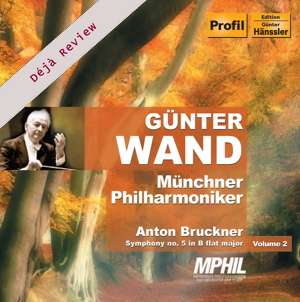
Déjà Review: this review was first published in September 2007 and the recording is still available.
Anton Bruckner (1824-1896)
Symphony No 5 in B-flat major (1875-7)
Munich Philharmonic Orchestra/Günter Wand
rec. 1995, Munich, Germany
Profil PH06012 [76]
The Symphony No. 5 provides us with the essence of Bruckner.
The fact that the composer never heard the music in performance is an indication of his pioneering and very personal approach to the symphony as an art form. The work was composed between February 1875 and August 1877, and although it was eventually performed at Graz in 1894, Bruckner was by that time too ill to undertake the journey from his home in Vienna. His career as a composer developed late and enjoyed all too few triumphs, with the result that he was often persuaded by well-meaning friends to rework his symphonies. In this respect the Fifth was lucky; since it lay unperformed for years, revisions by the composer himself were hardly possible.
However, an indication of the nature of the problems Bruckner faced during his lifetime can be understood from what happened at the first performance. The conductor was Franz Schalk, who was a great supporter of the composer. Even so, he made severe cuts in the finale, and deployed additional brass players in the closing stage in order to make a huge effect. In the light of these difficulties it is no wonder that Bruckner regularly suffered from depression, brought on also by financial hardship as well as the failure of so many of his contemporaries to comprehend his artistic aims and achievements. It was not until 1932 that the Fifth Symphony received a performance in the version in which it had originally been written.
However, some of the great Bruckner conductors, and most notably Hans Knappertsbusch, performed the Schalk revision. As for Günter Wand, he described it as ‘an abomination’.
The Fifth contains two features by which it differs from the remainder of Bruckner’s symphonies, and which are therefore crucial to an understanding of it. Both the first movement and the finale have slow introductions. The structure of the finale is a synthesis of sonata form and fugue, while employing also a powerful choral theme. There is eventually a rousing apotheosis built upon the return of the first movement’s principal theme.
Günter Wand is one of the legendary Bruckner conductors, and his many recordings have rightly achieved a classic status. In the Fifth Symphony, for example, there are also splendid recordings that he made in good sound with both the Cologne Radio Symphony Orchestra and the North German Radio Symphony Orchestra. The latter is perhaps the finest of the three alternatives – counting this one also. To be fair each of them will give enormous pleasure to the sensitive listener and will serve Bruckner’s cause well.
The slow introduction with which the symphony begins is some fifty bars long. It includes several fragments relating to material that will reach its full potential in the Allegro which comprises the first movement proper. In this Munich version, which was taken from two live performances, the introduction builds to a most impressive climax, before suddenly falling back to an atmospheric string tremolando. Shimmering violins provide the background as the cellos and violas present the principal theme in unison. When the movement culminates there is a triumphant restatement of this theme, with trombones to the fore, and at this compelling point it is hard to choose between Wand’s three recordings. In the present version, for instance, the playing of the Munich Philharmonic is magnificent.
The slow movement has a less complex design, and contains the emotional core of the symphony. Wand phrases the melodic lines with due care and attention, but it is his Hamburg (North German) performance which radiates the greatest warmth and the most compelling atmosphere. The highlight of the slow movement is the release of eloquent string music that envelops the principal theme, in which regard the Munich orchestra does not disappoint. Wand, like most conductors, keeps the music moving with careful sensitivity in the phrasing. But it is interesting to note that whereas he takes some fifteen minutes over the movement, Herbert von Karajan in his DG recording (415 985 2) with the Berlin Philharmonic, spans a full twenty-one minutes; and it works, too.
Bruckner hailed from rural Upper Austria, and this is readily apparent in his scherzo movements, which have their origins in peasant dances. The lively opening theme for woodwinds is nicely pointed here, and the delicate textures provide a foil to the more massive textures elsewhere.
The tradition of the post-Beethoven symphony demanded that the finale should attempt to resolve the issues presented during the course of the earlier movements, and in the Fifth Symphony Bruckner decided upon making his point with an intellectual show of strength. Thus the first three movements become an extended prelude to the finale, which begins with a slow introduction, as the first movement had done. Then Bruckner presents the ambitious combination of sonata, chorale and double fugue. The motto theme is transformed into the first fugue subject, and Wand characterises it with the utmost skill and understanding. The same is true of the second subject group or Gesangsperiode, and of the third too, which leads into an impressive chorale for the brass. At the conclusion the orchestra blazes forth with the chorale, above the rhythmic background of the motto, and the principal theme of the first movement returns to bring the symphony to its conclusion. In Wand’s performance the effect is simply galvanising.
Terry Barfoot
Buying this recording via a link below generates revenue for MWI, which helps the site remain free.



















